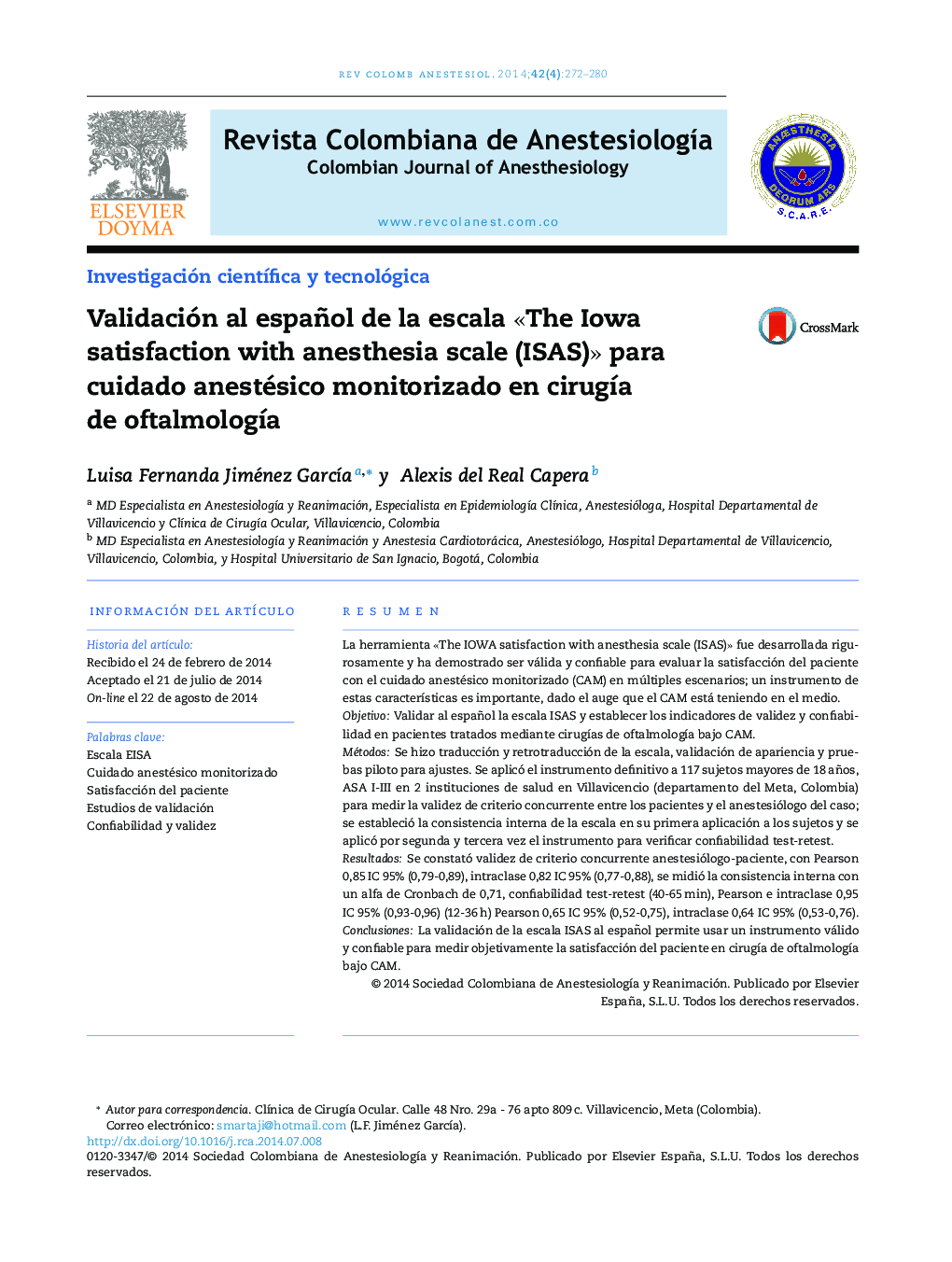| Article ID | Journal | Published Year | Pages | File Type |
|---|---|---|---|---|
| 2767847 | Revista Colombiana de Anestesiología | 2014 | 9 Pages |
ResumenLa herramienta «The IOWA satisfaction with anesthesia scale (ISAS)» fue desarrollada rigurosamente y ha demostrado ser válida y confiable para evaluar la satisfacción del paciente con el cuidado anestésico monitorizado (CAM) en múltiples escenarios; un instrumento de estas características es importante, dado el auge que el CAM está teniendo en el medio.ObjetivoValidar al español la escala ISAS y establecer los indicadores de validez y confiabilidad en pacientes tratados mediante cirugías de oftalmología bajo CAM.MétodosSe hizo traducción y retrotraducción de la escala, validación de apariencia y pruebas piloto para ajustes. Se aplicó el instrumento definitivo a 117 sujetos mayores de 18 años, ASA I-III en 2 instituciones de salud en Villavicencio (departamento del Meta, Colombia) para medir la validez de criterio concurrente entre los pacientes y el anestesiólogo del caso; se estableció la consistencia interna de la escala en su primera aplicación a los sujetos y se aplicó por segunda y tercera vez el instrumento para verificar confiabilidad test-retest.ResultadosSe constató validez de criterio concurrente anestesiólogo-paciente, con Pearson 0,85 IC 95% (0,79-0,89), intraclase 0,82 IC 95% (0,77-0,88), se midió la consistencia interna con un alfa de Cronbach de 0,71, confiabilidad test-retest (40-65 min), Pearson e intraclase 0,95 IC 95% (0,93-0,96) (12-36 h) Pearson 0,65 IC 95% (0,52-0,75), intraclase 0,64 IC 95% (0,53-0,76).ConclusionesLa validación de la escala ISAS al español permite usar un instrumento válido y confiable para medir objetivamente la satisfacción del paciente en cirugía de oftalmología bajo CAM.
The Iowa Satisfaction with Anesthesia Scale (ISAS) was rigorously developed and has been shown to be valid and reliable for evaluating patient satisfaction with monitored anesthesia care (MAC) in several scenarios. Such an instrument is important given the success that MAC is enjoying in the field.ObjectiveValidate the ISAS in Spanish and establish indicators of validity and reliability in patients undergoing ophthalmic surgeries with MAC.MethodsA translation and back-translation of the scale, face validity and pilot tests for adjustments were completed. The final instrument was applied to 117 subjects over18 years of age, ASA I–III, in two healthcare institutions in Villavicencio (Meta Department, Colombia) in order to measure the concurrent criterion validity between the patients and the anesthesiologist of the case. The internal consistency of the scale was established in its first application to the subjects and later applied for the second and third times to verify the test–retest reliability.ResultsA Pearson anesthesiologist/patient concurrent criterion validity 0.85 CI 95% (0.79–0.89), intra-class 0.82 CI 95% (0.77–0.88), was confirmed. Internal consistency was measured with a Cronbach's alpha of 0.71. Test–retest reliability (40–65 min) was measured with Pearson and intra-class 0.95 CI 95% (0.93–0.96) and, (12–36 h) Pearson 0.65 CI 95% (0.52–0.75), intra-class 0.64 CI 95% (0.53–0.76).ConclusionsThe validation of the ISAS in Spanish allows for the use of a valid and reliable instrument to objectively measure the satisfaction of the patient in ophthalmic surgery under MAC.
